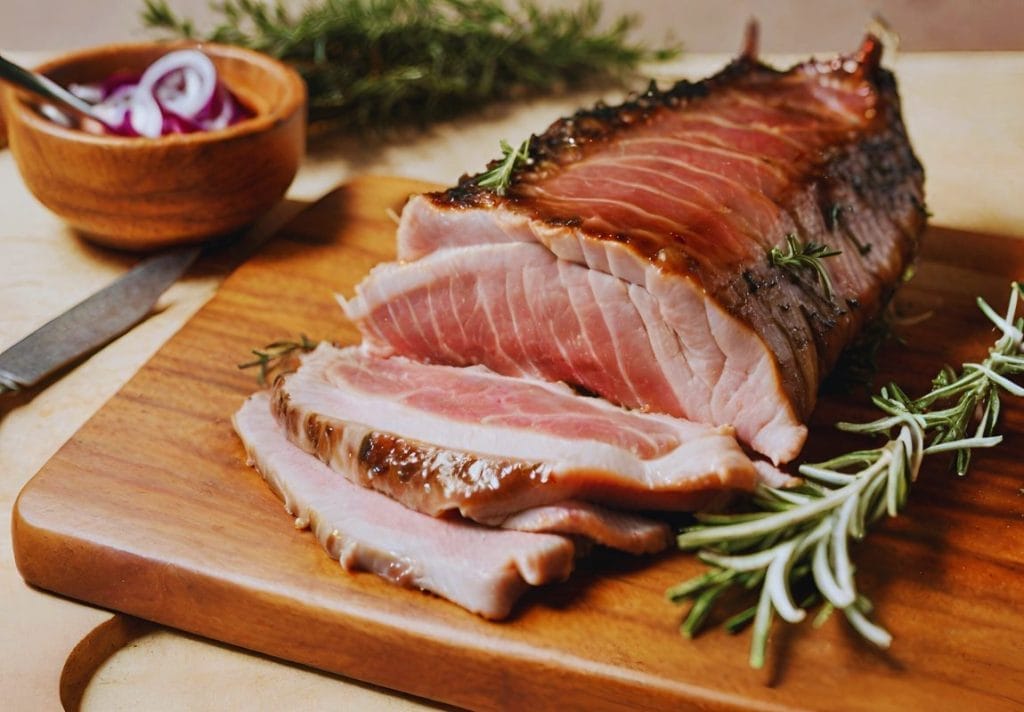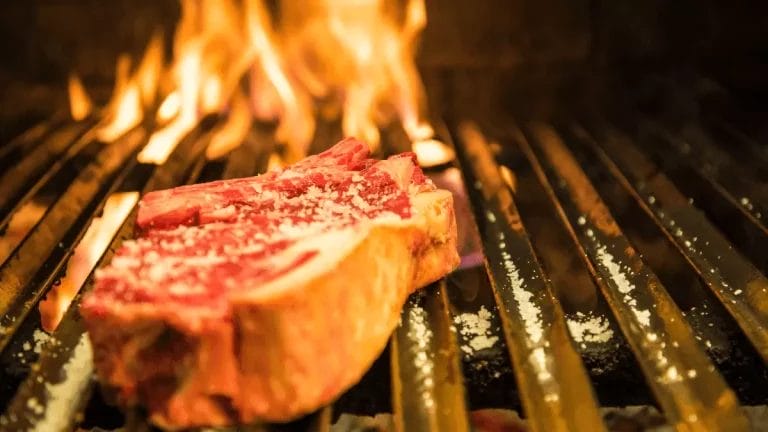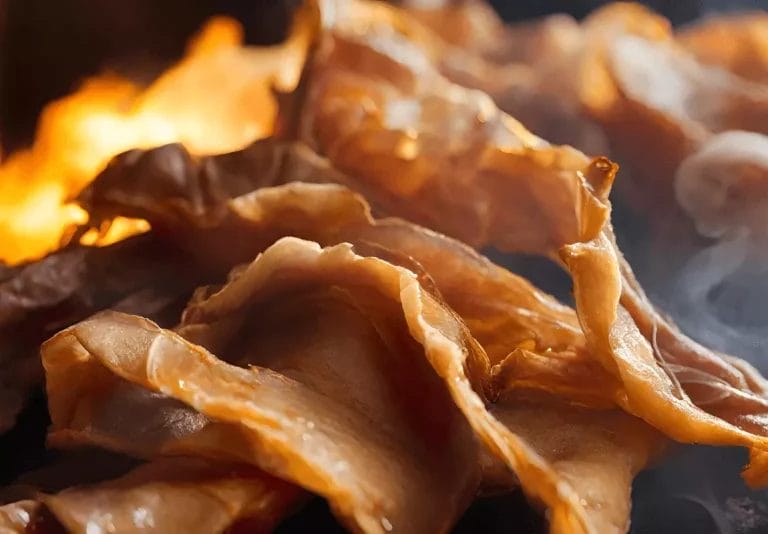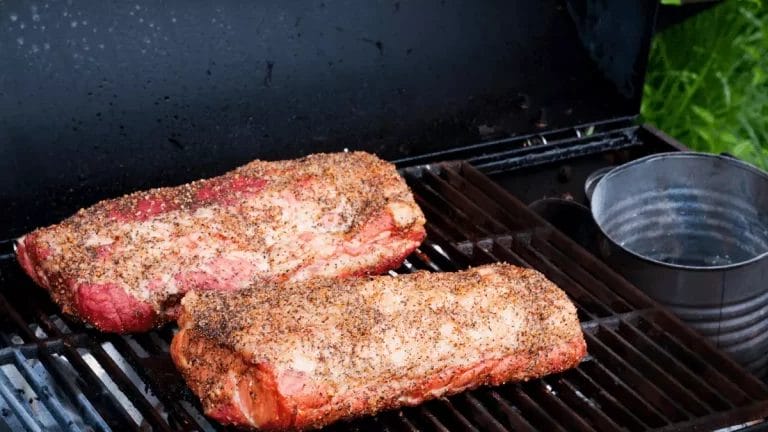What is a Pork Brisket? A Complete Guide

Prepare yourself for a culinary adventure into the realm of pork brisket, a cut that often lingers in the shadow of its bovine counterpart.
This exploration will reveal how to transform a tougher slice into a succulent masterpiece, employing methods such as smoking and slow cooking to achieve optimal tenderness.
Through your refined skills, pork brisket could very well become the star of your barbeque gatherings, impressing attendees with its rich taste and inviting consistency.
Embark on the journey to uncover the scrumptious enigmas that pork brisket holds.
Key Takeaways
- A pork brisket is a cut of meat from the chest region of pigs, similar to beef brisket.
- Like beef brisket, pork brisket is a tough and fatty cut that requires long, slow cooking to break down collagen and become tender.
- Pork brisket can be prepared by smoking or braising/roasting, with smoking imparting a desirable smoky flavor.
- Different regional styles of barbecue, such as Texas style and Kansas City style, can influence the seasoning and preparation method of pork brisket.
Pork Brisket Explained
Every cut of pork brisket you encounter is a tough, flavorful portion from the animal’s chest, requiring your patience and slow cooking to tenderize. Unlike its beef counterpart, the pork brisket, often overshadowed, is a meat cut steeped in potential when approached with finesse.
Smoking brisket, a method revered by connoisseurs, imbues the meat with a smoky depth that melds stunningly with a meticulously crafted brisket rub, enhancing the complexity of flavours.
Cooking brisket is an art form; it demands a low and leisurely tempo, allowing the heat to gently coax the fibres into succulence. As you master the nuances of pork brisket explained, each step—from trimming to the final slice—becomes a testament to the skill, transforming this robust cut into a tender, palate-pleasing delicacy.
Cooking Methods Compared
After mastering the basics of pork brisket, you’ll find that smoking and braising are two primary methods that can greatly influence the texture and flavour of your meat. Smoking, a technique often associated with beef brisket, imparts a rich, complex flavour.
With pork, a lower brisket temperature is maintained to slowly render the fat and break down connective tissues, creating a tender, smoked brisket. Braising, on the other hand, involves cooking the brisket in a flavorful liquid, which makes for a succulent and juicy result.
The right brisket seasoning plays a pivotal role in both methods.
| Cooking Method | Flavor Profile | Texture |
|---|---|---|
| Smoking | Smoky, complex | Tender |
| Braising | Rich, aromatic | Juicy |
| Grilling | Charred, savory | Firm |
Each cooking method unlocks a different dimension of the pork brisket, so choose your technique based on the desired outcome.
Regional Barbecue Styles
As you explore the world of pork brisket, you’ll discover that each regional barbecue style brings its own unique set of flavours and traditions to this beloved cut.
In Texas, for instance, barbecuing brisket is an art form, where the meat is often seasoned with a simple yet robust blend of salt and pepper before smoking. This allows the natural flavours of the beef brisket to shine through. But pork brisket can be treated similarly, absorbing the rich, smoky essence that’s signature to Texas-style barbecue.
- Texas Style: Reveres the simplicity of salt and pepper on brisket, emphasizing smoking techniques.
- Kansas City Style: Known for its rich, tomato-based sauces that envelop pork brisket in a tangy, sweet glaze.
- Smoking vs. Braising: Smoking imparts a deep, woody character to brisket, contrasted by braising, which offers a more subtle flavour and tender texture.
Dive into these methods, and you’ll refine your barbecuing skills to masterful levels.
Understanding Muscle Anatomy
Delving into the muscle anatomy of pork brisket, you’ll notice it’s structured similarly to beef, with both containing the tougher point and the leaner flat that each requires careful attention when cooking. The brisket cut lies over the chest, a region that works hard, resulting in more connective tissue and a robust flavour profile. Your mastery of this meat hinges on understanding how to navigate its complexity during preparation.
As you dissect the pork brisket, you’ll encounter dense muscle fibres intertwined with fat. It’s this interplay that demands a low and slow approach to cooking. Breaking down the collagen within these muscles transforms the brisket into a succulent, tender delight. Honing the art of preparing this cut ensures you’ll unlock the full potential of pork’s rich, savoury essence.
Preparation and Seasoning

You’ll need to season your pork brisket generously to enhance its natural flavours before cooking. Begin your preparation by selecting a brisket rub or spice blend that complements pork’s rich profile. Whether you opt for a dry seasoning or a wet brisket marinade, ensure that it’s thoroughly applied to penetrate the meat’s surface.
Here’s how to keep your audience’s taste buds tingling:
- Experiment with a brisket rub that includes brown sugar, smoked paprika, and garlic powder for a balance of sweet and savoury.
- Consider a brisket marinade with apple cider vinegar and Dijon mustard to tenderize and infuse the meat.
- Don’t rush the seasoning process; allow the brisket to rest with the rub or marinade for several hours to deepen the flavours.
Mastering the preparation and seasoning of pork brisket is crucial for a succulent and memorable brisket recipe.
Common Cooking Mistakes
Despite your best efforts in seasoning, it’s easy to make a few common mistakes that can ruin your pork brisket’s texture and flavour.
Overlooking the difference between the brisket flat and the point can lead to uneven cooking, as the leaner flat cooks faster than the fattier point.
Not using a brisket wrap when you hit the infamous brisket stall—a temperature plateau during cooking—can extend your brisket time unnecessarily.
Also, applying brisket sauce too early can cause it to burn, creating a bitter taste.
Remember, patience is key; rushing the process with high heat will leave your brisket tough.
Frequently Asked Questions
Can Pork Brisket Be Used as a Substitute for Beef Brisket in Recipes, and How Does the Substitution Affect the Dish’s Flavor Profile?
Swapping pork brisket for beef brisket is feasible, yet it will impart a distinct flavour to your culinary creation. The milder, somewhat saccharine quality of pork offers a subtle divergence from the hearty taste profile typical of beef, infusing a fresh dimension into classic brisket dishes.
Are There Any Health or Nutritional Differences Between Pork and Beef Brisket That Consumers Should Be Aware Of?
When contemplating the choice between pork and beef brisket, be cognizant that pork brisket typically harbours a higher fat quotient, thereby influencing caloric and nutritive consumption. Align your selection with dietary objectives and wellness aspirations, given that both succulent, leisurely-cooked meats offer their own gustatory delights.
How Does the Market Availability and Price of Pork Brisket Compare to That of Beef Brisket?
Pork brisket tends to be less prevalent and typically carries a lower price tag than its beef counterpart, a reflection of consumer demand and customary butchery techniques. Becoming adept at its preparation may afford you an advantage in crafting varied, economical culinary creations.
What Are Some Creative Ways to Repurpose Leftover Pork Brisket Into New Meals?
You have the opportunity to transmute your remaining pork brisket into a robust chilli, delectable tacos, or a sumptuous topping for ramen. Unleash your culinary creativity by crafting brisket-filled empanadas or incorporating them within a lasagna for an inventive spin on traditional fare.
How Do Different Wood Types Used in Smoking Pork Brisket Influence the Final Taste of the Dish?
Various types of timber confer distinct savours upon your smoked pork brisket; hickory bestows an intense, bacon-esque flavour, whereas applewood grants a gentler, sugary accent, which amplifies the meat’s inherent savours. Opt for your timber based on personal taste predilections.
Conclusion
Having ventured through the realm of pork brisket, you’re now equipped with the wisdom to master this hearty cut.
Whether you opt for smoking or braising, the essential strategy is a gentle and prolonged heat application.
Embrace the distinct characteristics of the fat-laden point and the leaner flat.
Season with a bold hand, cook with patience, sidestep typical blunders, and prepare to dazzle with a juicy, flavour-rich pork brisket that will beckon guests for another helping.
Your gastronomic quest beckons—venture forth and triumph over the brisket!



